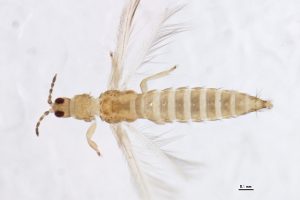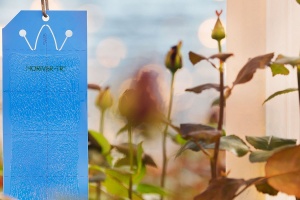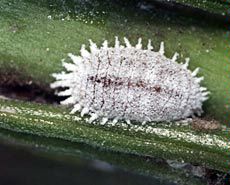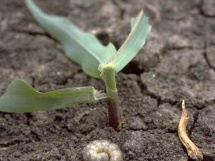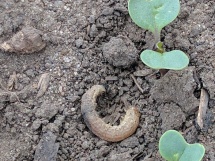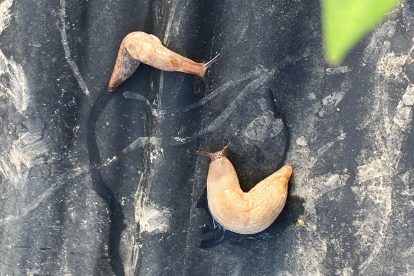Fungus Gnats
Occurrence: Active Now | Greenhouses Transplant Production and House Plants
Description: Fungus gnats are small (3mm) mosquito-like insects. The worm-like larvae are clear with black heads. Gnat eggs are laid in the top 2-3 inches of potting media. When the larvae emerge, they will stay in the soil feeding on plant root hairs, fungi, and decaying plant matter. Pupation also occurs in the soil.
Monitoring: Plants suffering from damage from fungus gnat larvae will have poor, stunted growth. Young plants are especially susceptible. If the pot size is large enough, press potato slices into the soil surface. If larvae are present, they can be found on the top and bottom of the potato within 24-48 hours. Adult fungus gnats can be seen flying around infested plants, particularly when the plant is disturbed. Place yellow sticky traps around plants to help monitor adult gnat populations.
Management:
- Fungal gnats thrive in moist environments. Ensure plants have proper drainage and allow soil to dry between waterings.
- Quarantine new transplants before bringing them inside a greenhouse or home to prevent introducing fungus gnats.
- Some natural predators can be purchased and released into greenhouses and high tunnels for biocontrol. These species include the predatory rove beetle Dalotia coriaria, soil-dwelling predatory mite Stratiolaelaps scimitus, and the beneficial nematode Steinemema feltiae.
Reference:
- Fungus Gnats in the Home (USU Extension Fact Sheet)
- Greenhouse Pest Management Video (USU Extension)
Voles
Occurrence: Active Now | Voles do not hibernate and can cause damage year-round, especially in high tunnels.
Description: Voles are small rodents ranging in color from brown to gray with some black hairs. They have short legs, small ears and a stocky nose. Adults are 3 to 6 inches in length, with tails extending, ¾ of an inch to 4 inches. There are 5 species of voles in Utah, however the meadow vole (Microtus pennsylvanicus) is the most common. Voles can damage vegetable crops, especially in high tunnels as well as the roots and bark at the base of trees and ornamentals.
Management: Voles are most active at night, so monitor for voles by looking for runways approximately 2 inches wide in turf and for damage on trees and ornamentals. If management is deemed necessary, a variety of traps are available utilizing rodenticides* that contain diphacinone, live trapping options can be considered for less lethal methods, and regular mouse traps with a peanut butter- oat bait could also be effective provided they are covered to protect children, pets and wildlife.
*Rodenticides are intended to kill mammals and should be used with caution around humans, access for other mammals and as well as birds and fish should be prevented in order to not harm wildlife.
Additional References:
- Voles (USU Extension Fact Sheet)
- Controlling Voles in Horticulture Plantings and Orchards in Missouri (Missouri Extension)
- Vole Control Video (USU Extension)
- How to Control Pocket Gophers and Voles Video (USU Extension)
Thrips
Occurrence: Active Now | Greenhouses Transplant Production and High Tunnels
Description: Both onion thrips and western flower thrips can be found in Utah greenhouses. In both species adults are yellow-brown with elongated bodies, and fringed wings. Larvae look like lighter-colored, wingless versions of adults. They feed by piercing and sucking out plant juices. Besides feeding damage, thrips can also spread diseases.
Monitoring: Thrip feeding can cause silvery scars or marks on leaves and fruit. Another common sign of thrips is shiny black spots of excrement around feeding sites. Using yellow and blue sticky traps early in the season can help monitor for thrips populations.
Management:
- Prevent thrips from being introduced to the greenhouse by quarantining new plants.
- Remove weeds in and around the greenhouse that can act as alternative hosts for the thrips.
- For biological control, the predatory mite, Amblyseius swirskii, can be purchased from insectaries and released in the high tunnel or greenhouse. They are sold in sachets, which are small bags containing mites and a food source, allow for slow but consistent release over several weeks. The bags can be hung above or on plants. Mites can also be purchased in shakers and dispensed where thrip populations are dense.
References:
- Thrips Management in High Tunnels (USU Extension Fact Sheet)
- Greenhouse Pest Management Video (USU Extension)
Mealy Bugs
Occurrence: Active Now | Greenhouses Transplant Production
Description: Mealy bugs are soft-bodied, oval-shaped insects. They are very small (3mm) and have white wax covering their body. Adults are slow-moving due to their waxy outercoat. Nymphs are orange or pink and begin to build up wax after choosing a spot to feed. Mealybugs tend to congregate in areas protected by leaves or fruit. Mealybugs feed on sap they suck from plant stems or foliage.
Monitoring: Mealybug feeding will reduce plant vigor, causing leaves to yellow, wither, and drop. Scout for symptoms of mealybug feeding, as well as accumulation of wax and honeydew excreted by the mealybugs.
Management:
- Quarantine new plants to prevent introducing mealy bugs to the greenhouse.
- Different insecticides may be required at different stages in the life of mealybugs. Examples of effective ingredients include acephates, azadirachtin + pyrethrins, or chlorpyrifos + cyfluthrins.
- Some natural predators can be purchased and released into greenhouses and high tunnels for biocontrol. These species include lacewings, mealybug destroyers (Cryptolaemus montrouzieri), the parasitic wasps Anagyrus pseudococci, and Leptomastix dactylopii.
References:
- Mealybugs (North Carolina State University Extension Fact Sheet)
- Mealybugs (California Cooperative Extension Fact Sheet)
- Greenhouse Pest Management Video (USU Extension)
Cutworms
Occurrence: Active Now | High Tunnel Production
Description:Cutworms larvae overwinter in the soil or underneath plant debris. Various species found in Utah include the Army Cutworm (Euxoa auxiliaris), Black Cutworm (Agotis ipsilon), Glassy cutworm (Crymodes devastator), Pale Western Cutworm (Agrotis orthogonia), and Variegated Cutworms (Peridroma saucia).
Monitoring: Look for seedlings that have been cut off at the base, then use a trowel to dig and search for larvae in the base soil. Cutworms are most active at night, so searching with a flashlight may help identify populations. Commercial growers should consider treatment when the threshold reaches five larvae per yd2.
Management:
- Remove cool-season garden weeds that are alternate hosts to cutworms such as lambquarters and wild mustards that are growing near your field edges or garden.
- Sites with an early season weed infestation are often more susceptible. Protect seedlings by using cardboard collars, screens, and protective cloths at the base of the plants. These barriers should be at least 2-3 inches tall and pushed firmly in the soil to prevent cutworms from crawling under. I
- Insecticide treatments with the active ingredients. Bacillus thuringiensis, spinosad, and insecticidal soap to kill the larvae.
Additional References:
- April 2020 Vegetable Pest Advisory (USU Extension)
- Caterpillar Management in High Tunnels (USU Extension)
Whitefly
Occurrence: Active Now | Greenhouses Transplant Production
Description: Common whitefly species in Utah include the greenhouse whitefly and silverleaf whitefly. Both species are tiny, white, winged insects when adults. Nymphs are immobile oval-shaped, and translucent. Adults and nymphs will feed on leaves with piercing, straw-like mouthparts.
Monitoring: Whitefly feeding can cause leaves to yellow and drop. Large whitefly populations can cause leaves to become distorted. Use yellow sticky traps can help monitor whitefly populations. Scout the undersides of leaves for whitefly nymphs and eggs.
Management:
- Whitefly populations are often introduced to greenhouses through infected plants. Quarantine plants before moving them into a greenhouse or home.
- Consider allowing a “crop-free period” inside the greenhouse to “break” the life cycle of whiteflies by removing their food sources. Ensure all alternate hosts, such as weeds, are also removed.
- There are several conventional and organic pesticides are labeled for whitefly control. They include active ingredients such as horticultural oils, pyrenthrin, azadirachtin, bifenthrin, cyfluthrin, and acephate. Always review product labels for instructed use.
- Some natural predators can be purchased and released into greenhouses for biocontrol. These species include the predatory mite Amblyseius swirskii, predatory beetle Delphastus catalinae, and parasitic wasps Encarsia formosa and Eretmocerus eremicus.
References:
- Whiteflies (Colorado State University Extension Fact Sheet)
- Whiteflies (University of New Hampshire Extension Fact Sheet)
Slugs and Snails
Occurrence: Active Now | High Tunnel Transplant Production
Description: Slugs and snails are terrestrial mollusks with soft bodies, they are closely related with the major difference being snails have a hard shell. They need moist environments to lay their eggs and survive the heat of the day.
Monitoring: Snails and slugs will leave a silvery mucus trail on plants they have visited so their presence will be evident.
Management:
- Physical barriers like diatomaceous earth are irritating to snails and slugs, but not lethal. They will avoid plants that it is spread around, however it becomes ineffective once it is wet, so it requires reapplication.
- View slug and snail control products here.
References:
Mule Deer
Occurrence: Active Now | Present in Lower Elevations due to Snow Depths
Description: Mule deer (Odocoileus hemionus) are the most common big game species in Utah, and feed on a variety of trees and ornamentals in the foothills and valleys as their natural food becomes scarce in the winter months. Damage may include torn leaves from feeding, as well as trampled plants and shredded bark from rubbing their antlers on trees.
Management:
- Fencing, and physical barriers though sometimes costly and time consuming can be considered to reduce browsing damage. An 8-foot fence would ensure no deer could jump over. However, if that is not doable any fence over 5 feet should reduce browsing but may not eliminate it.
- Covering shrubs in burlap or another material over winter and using tree protectors year-round can help to protect from damage but may not be aesthetically pleasing.
- Planting native unpalatable plants that dear do not browse is also a great option to reduce damage without sacrificing looks.
References:








